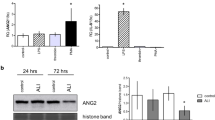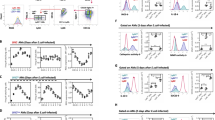Abstract
Caveolin-1 is one of the important regulators of vascular permeability in inflamed lungs. Podocalyxin is a CD34 protein expressed on vascular endothelium and has a role in podocyte development in the kidney. Few data are available on the expression of caveolin-1 and podocalyxin in lungs challenged with Toll-like receptor 2 (TLR2) agonists such as mycoplasma-derived macrophage activating lipopeptide or with immune modulators such as Fms-like tyrosine kinase receptor-3 ligand (Flt3L), which expands dendritic cell populations in the lung. Because of the significance of pathogen-derived molecules that act through TLR2 and of the role of immune modulators in lung physiology, we examine the immunohistochemical expression of caveolin-1 and podocalyxin in lungs from rats challenged with a 2-kDa macrophage-activating lipopeptide (MALP-2) and Flt3L. Normal rat lungs expressed caveolin-1 in alveolar septa, vascular endothelium and airway epithelium, especially along the lateral borders of epithelial cells but not in alveolar macrophages. MALP-2 and Flt3L decreased and increased, respectively, the expression of caveolin-1. Caveolin-1 expression seemed to increase in microvessels in bronchiole-associated lymphoid tissue (BALT) in Flt3L-challenged lungs but not in normal or MALP-2-treated lungs. Podocalyxin was absent in the epithelium and alveolar macrophages but was present in the vasculature of control, Flt3L- and MALP-2-treated rats. Compared with control and MALP-2-treated rats, Flt3L-treated lungs showed greater expression of podocalyxin in BALT vasculature and at the interface of monocytes and the endothelium. These immunohistochemical data describing the altered expression of caveolin-1 and podocalyxin in lungs treated with MALP-2 or Flt3L encourage further mechanistic studies on the role of podocalyxin and caveolin-1 in lung inflammation.







Similar content being viewed by others
References
Agarwal N, Lippmann ES, Shusta EV (2010) Identification and expression profiling of blood–brain barrier membrane proteins. J Neurochem 112:625–635
Alonso-Martin S, Nowakowski A, Larrucea S, Fernandez D, Vilar-Egea M, Ayuso MS, Parrilla R (2010) Overexpression of podocalyxin in megakaryocytes and platelets decreases the bleeding time and enhances the agonist-induced aggregation of platelets. Thromb Res 125:e300–e305
Andonegui G, Bonder CS, Green F, Mullaly SC, Zbytnuik L, Raharjo E, Kubes P (2003) Endothelium-derived Toll-like receptor-4 is the key molecule in LPS-induced neutrophil sequestration into lungs. J Clin Invest 111:1011
Auriac A, Willemetz A, Canonne-Hergaux F (2010) Lipid raft-dependent endocytosis: a new route for hepcidin-mediated regulation of ferroportin in macrophages. Haematologica 95:1269–1277
Brant KA, Fabisiak JP (2008) Nickel alterations of TLR2-dependent chemokine profiles in lung fibroblasts are mediated by COX-2. Am J Respir Cell Mol Biol 38:591–599
Campbell L, Hollins AJ, Al-Eid A, Newman GR, von Ruhland C, Gumbleton M (1999) Caveolin-1 expression and caveolae biogenesis during cell transdifferentiation in lung alveolar epithelial primary cultures. Biochem Biophys Res Commun 262:744–751
Chavakis T, Preissner KT, Santoso S (2003) Leukocyte trans-endothelial migration: JAMs add new pieces to the puzzle. Thromb Haemost 89:13–17
Deiters U, Muhlradt PF (1999) Mycoplasmal lipopeptide MALP-2 induces the chemoattractant proteins macrophage inflammatory protein 1alpha (MIP-1alpha), monocyte chemoattractant protein 1, and MIP-2 and promotes leukocyte infiltration in mice. Infect Immun 67:3390–3398
Fernandez D, Horrillo A, Alquezar C, Gonzalez-Manchon C, Parrilla R, Ayuso MS (2013) Control of cell adhesion and migration by podocalyxin. Implication of Rac1 and Cdc42. Biochem Biophys Res Commun 432:302–307
Foti M, Granucci F, Pelizzola M, Beretta O, Ricciardi-Castagnoli P (2006) Dendritic cells in pathogen recognition and induction of immune responses: a functional genomics approach. J Leukoc Biol 79:913–916
Garrean S, Gao XP, Brovkovych V, Shimizu J, Zhao YY, Vogel SM, Malik AB (2006) Caveolin-1 regulates NF-kappaB activation and lung inflammatory response to sepsis induced by lipopolysaccharide. J Immunol 177:4853–4860
Horvat R, Hovorka A, Dekan G, Poczewski H, Kerjaschki D (1986) Endothelial cell membranes contain podocalyxin–the major sialoprotein of visceral glomerular epithelial cells. J Cell Biol 102:484–491
Hu G, Ye RD, Dinauer MC, Malik AB, Minshall RD (2008) Neutrophil caveolin-1 expression contributes to mechanism of lung inflammation and injury. Am J Physiol Lung Cell Mol Physiol 294:L178–L186
Kasper M, Reimann T, Hempel U, Wenzel KW, Bierhaus A, Schuh D, Dimmer V, Haroske G, Muller M (1998) Loss of caveolin expression in type I pneumocytes as an indicator of subcellular alterations during lung fibrogenesis. Histochem Cell Biol 109:41–48
Kasper M, Seidel D, Knels L, Morishima N, Neisser A, Bramke S, Koslowski R (2004) Early signs of lung fibrosis after in vitro treatment of rat lung slices with CdCl2 and TGF-beta1. Histochem Cell Biol 121:131–140
Kelley TW, Huntsman D, McNagny KM, Roskelley CD, Hsi ED (2005) Podocalyxin: a marker of blasts in acute leukemia. Am J Clin Pathol 124:134–142
Kerjaschki D, Sharkey DJ, Farquhar MG (1984) Identification and characterization of podocalyxin—the major sialoprotein of the renal glomerular epithelial cell. J Cell Biol 98:1591–1596
Kronstein R, Seebach J, Grossklaus S, Minten C, Engelhardt B, Drab M, Liebner S, Arsenijevic Y, Taha AA, Afanasieva T, Schnittler HJ (2012) Caveolin-1 opens endothelial cell junctions by targeting catenins. Cardiovasc Res 93:130–140
Larrucea S, Butta N, Rodriguez RB, Alonso-Martin S, Arias-Salgado EG, Ayuso MS, Parrilla R (2007) Podocalyxin enhances the adherence of cells to platelets. Cell Mol Life Sci 64:2965–2974
Lei MG, Tan X, Qureshi N, Morrison DC (2005) Regulation of cellular caveolin-1 protein expression in murine macrophages by microbial products. Infect Immun 73:8136–8143
Luhrmann A, Tschernig T, Pabst R, Niewiesk S (2005) Improved intranasal immunization with live-attenuated measles virus after co-inoculation of the lipopeptide MALP-2. Vaccine 23:4721–4726
Luhrmann A, Grote K, Stephan M, Tschernig T, Pabst R (2007) Local pulmonary immune stimulation by the Toll-like receptor 2 and 6 ligand MALP-2 in rats is age dependent. Immunol Lett 108:167–173
Ma AC, Kubes P (2008) Platelets, neutrophils, and neutrophil extracellular traps (NETs) in sepsis. J Thromb Haemost 6:415–420
Masten BJ, Olson GK, Kusewitt DF, Lipscomb MF (2004) Flt3 ligand preferentially increases the number of functionally active myeloid dendritic cells in the lungs of mice. J Immunol 172:4077–4083
Miettinen A, Solin ML, Reivinen J, Juvonen E, Vaisanen R, Holthofer H (1999) Podocalyxin in rat platelets and megakaryocytes. Am J Pathol 154:813–822
Minshall RD, Sessa WC, Stan RV, Anderson RG, Malik AB (2003) Caveolin regulation of endothelial function. Am J Physiol Lung Cell Mol Physiol 285:L1179–L1183
Mizgerd JP (2002) Molecular mechanisms of neutrophil recruitment elicited by bacteria in the lungs. Semin Immunol 14:123–132
Muhlradt PF, Kiess M, Meyer H, Sussmuth R, Jung G (1997) Isolation, structure elucidation, and synthesis of a macrophage stimulatory lipopeptide from Mycoplasma fermentans acting at picomolar concentration. J Exp Med 185:1951–1958
Newman GR, Campbell L, von Ruhland C, Jasani B, Gumbleton M (1999) Caveolin and its cellular and subcellular immunolocalisation in lung alveolar epithelium: implications for alveolar epithelial type I cell function. Cell Tissue Res 295:111–120
Nielsen JS, Graves ML, Chelliah S, Vogl AW, Roskelley CD, McNagny KM (2007) The CD34-related molecule podocalyxin is a potent inducer of microvillus formation. PLoS ONE 2:e237
Nielsen JS, McNagny KM (2009) The role of podocalyxin in health and disease. J Am Soc Nephrol 20:1669–1676
Orlando RA, Takeda T, Zak B, Schmieder S, Benoit VM, McQuistan T, Furthmayr H, Farquhar MG (2001) The glomerular epithelial cell anti-adhesin podocalyxin associates with the actin cytoskeleton through interactions with ezrin. J Am Soc Nephrol 12:1589–1598
Pabst R (1992) Is BALT a major component of the human lung immune system? Immunol Today 13:119–122
Pabst R, Tschernig T (2010) Bronchus-associated lymphoid tissue: an entry site for antigens for successful mucosal vaccinations? Am J Resp Cell Mol Biol 43:137–141
Pabst R, Luhrmann A, Steinmetz I, Tschernig T (2003) A single intratracheal dose of the growth factor Fms-like tyrosine kinase receptor-3 ligand induces a rapid differential increase of dendritic cells and lymphocyte subsets in lung tissue and bronchoalveolar lavage, resulting in an increased local antibody production. J Immunol 171:325–330
Pabst R, Durak D, Roos A, Luhrmann A, Tschernig T (2009) TLR2/6 stimulation of the rat lung: effects on lymphocyte subsets, natural killer cells and dendritic cells in different parts of the air-conducting compartments and at different ages. Immunology 126:132–139
Soong G, Reddy B, Sokol S, Adamo R, Prince A (2004) TLR2 is mobilized into an apical lipid raft receptor complex to signal infection in airway epithelial cells. J Clin Invest 113:1482–1489
Testa JE, Chrastina A, Li Y, Oh P, Schnitzer JE (2009) Ubiquitous yet distinct expression of podocalyxin on vascular surfaces in normal and tumor tissues in the rat. J Vasc Res 46:311–324
Volonte D, McTiernan CF, Drab M, Kasper M, Galbiati F (2008) Caveolin-1 and caveolin-3 form heterooligomeric complexes in atrial cardiac myocytes that are required for doxorubicin-induced apoptosis. Am J Physiol Heart Circ Physiol 294:H392–H401
von Wulffen W, Steinmueller M, Herold S, Marsh LM, Bulau P, Seeger W, Welte T, Lohmeyer J, Maus UA (2007) Lung dendritic cells elicited by Fms-like tyrosine 3-kinase ligand amplify the lung inflammatory response to lipopolysaccharide. Am J Respir Crit Care Med 176:892–901
Wang XM, Kim HP, Song R, Choi AM (2006) Caveolin-1 confers antiinflammatory effects in murine macrophages via the MKK3/p38 MAPK pathway. Am J Resp Cell Mol Biol 34:434–442
Ware LB, Matthay MA (2000) The acute respiratory distress syndrome. N Eng J Med 342:1334–1349
Wetterwald A, Hoffstetter W, Cecchini MG, Lanske B, Wagner C, Fleisch H, Atkinson M (1996) Characterization and cloning of the E11 antigen, a marker expressed by rat osteoblasts and osteocytes. Bone 18:125–132
Williams TM, Lisanti MP (2004) The caveolin genes: from cell biology to medicine. Ann Med 36:584–595
Author information
Authors and Affiliations
Corresponding author
Additional information
The work reported in this study was supported by grants from the Natural Sciences and Engineering Research Council of Canada. Dr. Mustafa al-Hadi was a recipient of an NSERC-Undergraduate Student Research Award.
Rights and permissions
About this article
Cite this article
Tschernig, T., Pabst, R., Kasper, M. et al. Expression of caveolin-1 and podocalyxin in rat lungs challenged with 2-kDa macrophage-activating lipopeptide and Flt3L. Cell Tissue Res 356, 207–216 (2014). https://doi.org/10.1007/s00441-013-1771-y
Received:
Accepted:
Published:
Issue Date:
DOI: https://doi.org/10.1007/s00441-013-1771-y




